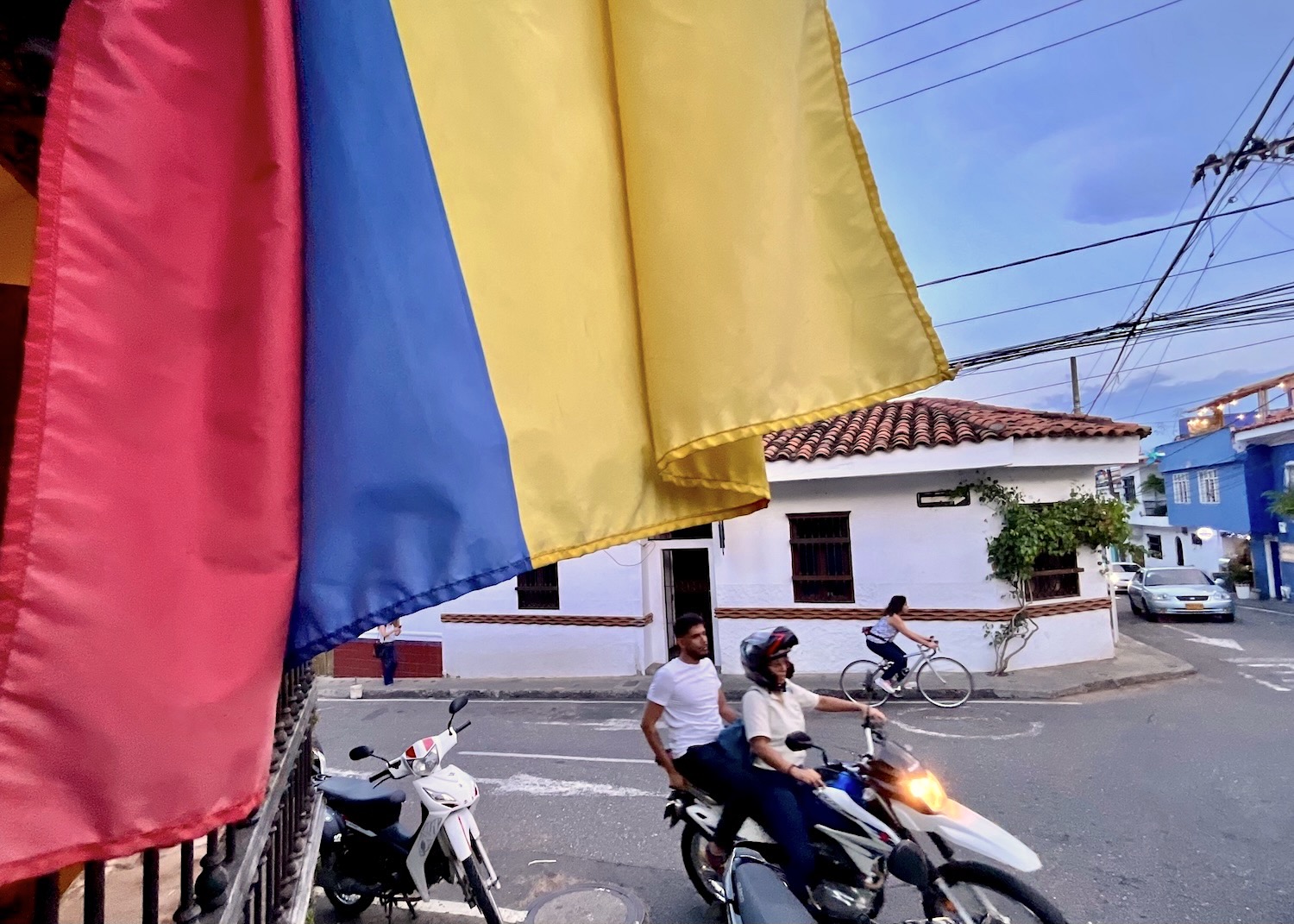
An investigation led by Gallup in 2023 reveals that nearly half of Colombians would leave the country if given the opportunity. This figure is not exaggerated. Indeed, in 2022, Colombia witnessed a record exodus, with 547,000 citizens leaving the country. This phenomenon is not new. For the past decades, millions of Colombians have emigrated, either in search of better economic opportunities or to escape insecurity and armed conflicts. Today, Colombian communities have taken root across the globe, with second-generation Colombians being born and raised in many host countries.
In this article, we will explore the global Colombian diaspora, travelling across the world to understand its history and characteristics.
Colombia, a nation built through immigration
Emigration is a relatively recent phenomenon in Colombian history. Like many Latin American countries, the Colombian modern nation was formed through significant and continuous migration waves, starting with the arrival of Spanish conquistadors in the early 16th century. As such, the native indigenous population was gradually overtaken by European settlers, primarily from Spain, but also from Germany, Italy, France, etc. Alongside Europeans, African slaves were also brought over continuously by traders until the 19th century, to work in mines and plantations, replacing indigenous labor. In addition to these main migration flows, Colombia also experienced significant migration from Levantine countries, notably Lebanon, starting in the late 19th century.
The factors behind Colombian emigration
Until the mid-20th century, Colombia was a country of immigration, experiencing positive net migration. However, this trend shifted dramatically in the 1960s, with the onset of the Colombian internal armed conflict. This civil war began in 1964 with the formation of far-left revolutionary groups like FARC and ELN and later involved several other groups, including paramilitaries and drug cartels. Coupled with the economic recession of the late 1990s, these events have led millions of Colombians to leave the country. According to official data from the Colombian Foreign Affairs Ministry (Ministerio de Relaciones Exteriores), there were 1,203,521 Colombians living abroad as of November 2022. However, this figure is considered an underestimate; more realistic estimates suggest the number of Colombians abroad is at least three million.
The characteristics of the Colombian diaspora
Emigrants come from all levels of Colombian society, from highly educated, wealthy groups to those of middle and lower incomes. Notably, a significant number are women, who constitute about 55 percent of the total. Today, Colombian migration is mostly driven by the pursuit of better economic opportunities and safety, with the emigrants mainly originating from the Andean Region and major cities like Bogota, Medellin, and Cali. The destinations for Colombian emigrants largely reflect historical, cultural, and economic ties, with the Colombian diaspora primarily settling in North America, Europe, and Latin America. The United States, Spain and Venezuela are the top host countries, hosting three-fourths of the Colombian diaspora.
Venezuela, a historical home to the Colombian diaspora
For centuries, Colombia and Venezuela have been part of the same territorial entity, successively known as the New Kingdom of Granada and the Viceroyalty of New Granada (1538-1821), under Spanish rule, and briefly as an independent state known as Greater Colombia (Gran Colombia), until 1831. This common history led the two countries to be dubbed as “Sister Nations” (Naciones Hermanas) and to sustain continuous cultural and human exchanges.
Consequently, Venezuela became the primary destination for Colombian emigrants, welcoming continuous and significant waves of migrants from the 1950s. At the time, Venezuela was a prosperous nation, with a dynamic economy notably boosted by a boom in oil exploitation during the 1970s. As such, the country was seen as an attractive option for Colombians seeking better living conditions. At its height in the 1990s, the Colombian diaspora in Venezuela could have represented as many as five million people, including both legal and illegal residents.

Political tensions and the end of the Venezuelan Dream
However, the ascent of Hugo Chavez and his left-wing nationalistic Bolivarian movement in Venezuela radically altered relations with Colombia, leading to constant diplomatic conflicts between the two countries. The shift brought Colombian emigration to Venezuela to a halt and initiated a reversal of the migration flow. Nicolas Maduro’s rise to power, coupled with Venezuela’s economic crisis and US economic sanctions, made Venezuela itself a country of massive emigration. This shift significantly impacted Colombians, with hundreds of thousands returning to Colombia. Intriguingly, Colombian migrants have even been blamed by several Venezuelan political figures for contributing to the economic turmoil, as many Colombians living in Venezuela were living in poverty.
The current state of the Colombian diaspora in Venezuela
Today, accurately assessing the number of Colombians living in Venezuela remains extremely challenging for several reasons. Firstly, because many Colombians have integrated into Venezuelan society, adopting Venezuelan citizenship. Secondly, because the Colombian migration to Venezuela has historically involved a significant degree of illegality, making it difficult to obtain precise data. However, in recent years, several authorities have tried to give an estimate of their number.
During the 2022 Colombian Presidential elections, the Colombian Consulate in Venezuela reported that 195,000 Colombian citizens were registered on electoral lists. Back in September 2022, the newly appointed Colombian ambassador to Venezuela estimated the number of Colombians in the country to be over four million, while the Association of Colombians in Venezuela suggested that it surpassed four and a half million. Meanwhile, the UN’s estimate for 2020 was of 918,000 individuals, a figure considered more reasonable. While providing a definitive figure for the Colombian diaspora in Venezuela is impossible, one thing is certain: it is among the largest and most vibrant in the world.
The Colombian diaspora in the United States
Regarding official figures, the United States hosts the largest Colombian diaspora globally, with around 1.4 million individuals residing in the country in 2021 according to the Pew Research Center, including 855,000 Colombian citizens. The Colombian population in the U.S. has seen a significant increase during the 21st century, growing from 500,000 to 1.4 million individuals over two decades. Today, Colombian Americans constitute the 24th largest diaspora in the United States and are the most important immigrant group from South America.
The majority of the Colombian Diaspora in the United States is concentrated in five states, accounting for 70 percent of the total Colombian population in the country. First is Florida, home to 30 percent of Colombian Americans, particularly in Miami-Dade and Palm Beach Counties. The other significant states are New York, New Jersey, California, and Texas, with Colombians predominantly living in major urban centers like New York City and Houston.

Patterns of Colombian emigration to the U.S.
Because of its historical political, economic, commercial and cultural influence over Colombia and Latin America, the U.S. continues to attract Colombians, who immigrate both legally and illegally, seeing the North American country as a ‘promised land’ of opportunity and success.
The first Colombian migrants arrived in the United States in the 1820s, although few sources detail their history as the U.S. did not distinguish Colombian migrants from other Latin American citizens in its records. Significant Colombian migration to the U.S. began in the 1960s, driven by the search for safety and better economic opportunities. This wave predominantly consisted of more highly educated middle and upper-class individuals.
Since the COVID-19 pandemic, Colombian migration patterns to the United States have shifted, with a significant number of Colombian citizens now attempting to enter the U.S. illegally through the U.S.-Mexico border. While only 10,000 Colombian citizens were arrested at the border in 2021, this number surged to 130,971 in 2022 and 152,974 in 2023.
Famous Colombian Americans
Colombian Americans, well-integrated into American society, have contributed talented individuals across various fields. Perhaps the most prominent representative of the Colombian diaspora in the U.S. is the actress Sofia Vergara, who emigrated from Barranquilla at the age of 26. She gained international fame for her role as Gloria Delgado-Pritchett on the sitcom “Modern Family”, from 2009 to 2020, becoming one of the highest-paid actresses in Hollywood. Other notable Colombians in the U.S. include music superstars Lil Pump and Kali Uchis, the latter having won a Grammy Award and two Billboard Music Awards, racing legend Juan Pablo Montoya, U.S congressmen Ruben Gallego and Scott Perry, both of Colombian descent, and NASA astronaut George Zamka.
Spain, the reverse-flow migration
Colombia was a colony within the Spanish Empire for over three centuries, and maintains deep linguistic, genetic, historical, and cultural connections with Spain. Historically, the country was an important destination for Spanish immigrants, who played a crucial role in shaping Colombia and Colombian culture, from culinary practices to religious traditions; nearly every Colombian has partial or full Spanish ancestry. A notable reflection of this heritage is the naming of Colombian cities after places in Spain, evidencing the deep historical ties. For example, Cartagena de Indias draws its name from the Spanish city of Cartagena in the Murcia region, while Medellin is named after its counterpart in the Extremadura region.
As emigration became a significant phenomenon within Colombian society, Spain emerged as a natural destination for Colombian migrants. Although Colombian emigration to Spain began only in the 1990s, the Colombian diaspora quickly became one of the country’s most significant communities.
Colombians in Spain
According to official data from the Spanish National Institute of Statistics, as of 2023, there were 715,655 Colombian-born citizens residing in Spain, making Colombians the second largest immigrant group after Moroccans. In the same year, Colombians were the leading immigrant group arriving in the country, mostly settling in the Madrid, Catalonia, and Valencia regions. Notably, almost one-third of the Colombian diaspora in Spain hails from the Valle del Cauca Department and the city of Cali.
Despite the relatively recent establishment of the Colombian community in Spain, several Colombians have left a significant mark, especially in Spanish football. In particular, Colombian talents like James Rodriguez at Real Madrid, Radamel Falcao with Atletico Madrid, and Carlos Bacca at FC Sevilla and Villareal have distinguished themselves, winning numerous European titles. In a recent highlight, a Colombian migrant from Bucaramanga captured national attention when her Catalonia-based restaurant, Fogón del Valle, was visited by King Filipe VI of Spain.

The Colombian diaspora, a global presence
Although the majority of Colombian migrants are concentrated in the United States, Venezuela and Spain, the Colombian diaspora extends globally, with communities present in various countries around the world.
In the Americas, Canada is home to over 70,000 Colombian migrants and approximately 100,000 individuals of Colombian descent, while Chile hosts a Colombian diaspora of over 160,000. Another significant Colombian community is found in Ecuador. Indeed, due to geographical proximity and shared historical and cultural ties, Ecuador is home to over 200,000 Colombians. Many of these migrants are refugees from the Colombian internal armed conflict, with as many as 70,000 Colombian citizens being officially recognized as refugees by the Ecuadorian authorities.
In Europe, outside of Spain, France boasts the largest Colombian diaspora, with around 100,000 people. Despite facing language and cultural differences, Colombians find France appealing for its economic opportunities and the allure of its artistic, architectural, gastronomical and cultural heritage. An agreement between the two countries allows Colombians aged 18 to 30 to obtain a one-year visa to work in France, facilitating youth mobility. In recent years, Germany, too, has seen an increase in Colombian migration, particularly among students and highly educated individuals. The country is actively seeking to encourage this trend as it studies a migration agreement aiming to attract skilled Colombian workers.
With a global presence, the Colombian diaspora actively spreads Colombian culture and works to debunk stereotypes, hopefully improving the reputation of this beautiful country.
See all the latest news from Colombia and the world at ColombiaOne.com. Contact our newsroom to report an update or send your story, photos and videos. Follow Colombia One on Google News, Facebook, Instagram, and subscribe here to our newsletter.

